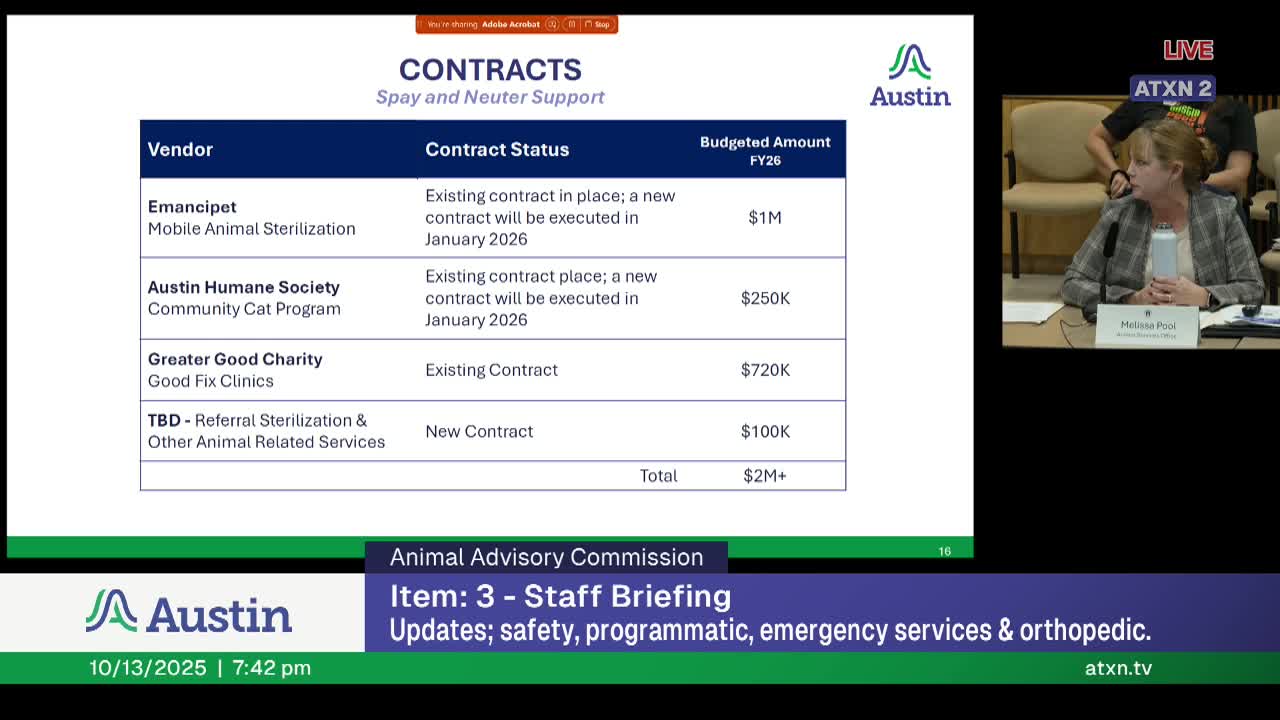AAS outlines FY26 spay/neuter budget and contract shifts; Emancipet extension prioritized for sterilizations
October 13, 2025 | Austin, Travis County, Texas
This article was created by AI summarizing key points discussed. AI makes mistakes, so for full details and context, please refer to the video of the full meeting. Please report any errors so we can fix them. Report an error »

Austin Animal Services (AAS) told the Bridal Advisory Commission on Oct. 13 that the department's FY26 operating plan allocates about $2 million to spay/neuter services distributed across several contractors and vendors and that the department has instructed Emancipet (contract extension) to devote a minimum portion of funds to spay/neuter operations.
Budget breakdown and strategy: Interim Chief Administrative Officer Melissa Poole presented the department's FY26 operating budget and explained administration and personnel changes approved in the annual budget cycle. Poole and Rolando Fernandez said AAS planned four parallel spay/neuter contracting streams for FY26: Emancipet, GreaterGood/Goodfix (mobile clinics), Austin Humane Society (community-cat/TNR work) and a proposed voucher/referral program. "We are allocating over $2,000,000 for spay and neuter support," Poole said.
Emancipet contract and priorities: Poole and Fernandez told commissioners that AAS extended Emancipet's existing contract through January to maintain services while the city drafts a competitive procurement. Fernandez said AAS has directed that at least 75% of Emancipet funds be used for spay/neuter (rather than other services such as microchip or vaccinations), and that the procurement will include performance reporting on surgical prioritization (for example, medium and large female dogs).
Proposed reductions and emergency services: As part of the city's required 5% budget savings exercise, Poole explained staff proposed a $160,000 reduction to the animal specialty surgery contract and a reduction in funding for emergency veterinary services that had covered some after-hours emergency procedures. Poole said the emergency clinic reduction was made with contingency planning; AAS is looking at alternative funding or contracting models for after-hours care for animal-protection officers and is monitoring whether council code changes (related to a separate item discussed in public comment) produce offsets. "If the council-directed change reduces intake that yields savings, we'll use that to support emergency services, but we are keeping a placeholder in case it doesn't," Poole said.
Why it matters: The allocation and the new procurement terms shape which animals get sterilized, how quickly, and whether community-based spay/neuter programs reach underserved areas. Commissioners and members of the public asked for clearer reporting on outcomes tied to outreach and social-media metrics, and for ongoing contractor accountability.
Ending: Poole and Fernandez said staff will continue to negotiate procurement language, monitor provider prioritization for higher-need animals, and provide updates to the commission. Commissioners urged AAS to provide periodic, clearer outcome reports tying social-media/workshop outreach to adoption and sterilization outcomes.
Budget breakdown and strategy: Interim Chief Administrative Officer Melissa Poole presented the department's FY26 operating budget and explained administration and personnel changes approved in the annual budget cycle. Poole and Rolando Fernandez said AAS planned four parallel spay/neuter contracting streams for FY26: Emancipet, GreaterGood/Goodfix (mobile clinics), Austin Humane Society (community-cat/TNR work) and a proposed voucher/referral program. "We are allocating over $2,000,000 for spay and neuter support," Poole said.
Emancipet contract and priorities: Poole and Fernandez told commissioners that AAS extended Emancipet's existing contract through January to maintain services while the city drafts a competitive procurement. Fernandez said AAS has directed that at least 75% of Emancipet funds be used for spay/neuter (rather than other services such as microchip or vaccinations), and that the procurement will include performance reporting on surgical prioritization (for example, medium and large female dogs).
Proposed reductions and emergency services: As part of the city's required 5% budget savings exercise, Poole explained staff proposed a $160,000 reduction to the animal specialty surgery contract and a reduction in funding for emergency veterinary services that had covered some after-hours emergency procedures. Poole said the emergency clinic reduction was made with contingency planning; AAS is looking at alternative funding or contracting models for after-hours care for animal-protection officers and is monitoring whether council code changes (related to a separate item discussed in public comment) produce offsets. "If the council-directed change reduces intake that yields savings, we'll use that to support emergency services, but we are keeping a placeholder in case it doesn't," Poole said.
Why it matters: The allocation and the new procurement terms shape which animals get sterilized, how quickly, and whether community-based spay/neuter programs reach underserved areas. Commissioners and members of the public asked for clearer reporting on outcomes tied to outreach and social-media metrics, and for ongoing contractor accountability.
Ending: Poole and Fernandez said staff will continue to negotiate procurement language, monitor provider prioritization for higher-need animals, and provide updates to the commission. Commissioners urged AAS to provide periodic, clearer outcome reports tying social-media/workshop outreach to adoption and sterilization outcomes.
View full meeting
This article is based on a recent meeting—watch the full video and explore the complete transcript for deeper insights into the discussion.
View full meeting
